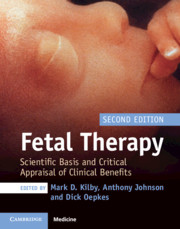Book contents
- Fetal Therapy
- Fetal Therapy
- Copyright page
- Dedication
- Contents
- Contributors
- Foreword
- Section 1: General Principles
- Section 2: Fetal Disease: Pathogenesis and Treatment
- Red Cell Alloimmunization
- Structural Heart Disease in the Fetus
- Fetal Dysrhythmias
- Manipulation of Fetal Amniotic Fluid Volume
- Fetal Infections
- Fetal Growth and Well-being
- Preterm Birth of the Singleton and Multiple Pregnancy
- Complications of Monochorionic Multiple Pregnancy: Twin-to-Twin Transfusion Syndrome
- Complications of Monochorionic Multiple Pregnancy: Fetal Growth Restriction in Monochorionic Twins
- Complications of Monochorionic Multiple Pregnancy: Twin Reversed Arterial Perfusion Sequence
- Complications of Monochorionic Multiple Pregnancy: Multifetal Reduction in Multiple Pregnancy
- Fetal Urinary Tract Obstruction
- Pleural Effusion and Pulmonary Pathology
- Surgical Correction of Neural Tube Anomalies
- Fetal Tumors
- Chapter 46 Fetal Tumors: Clinical Management
- Congenital Diaphragmatic Hernia
- Fetal Stem Cell Transplantation
- Gene Therapy
- Section III: The Future
- Index
- References
Chapter 46 - Fetal Tumors: Clinical Management
from Fetal Tumors
Published online by Cambridge University Press: 21 October 2019
- Fetal Therapy
- Fetal Therapy
- Copyright page
- Dedication
- Contents
- Contributors
- Foreword
- Section 1: General Principles
- Section 2: Fetal Disease: Pathogenesis and Treatment
- Red Cell Alloimmunization
- Structural Heart Disease in the Fetus
- Fetal Dysrhythmias
- Manipulation of Fetal Amniotic Fluid Volume
- Fetal Infections
- Fetal Growth and Well-being
- Preterm Birth of the Singleton and Multiple Pregnancy
- Complications of Monochorionic Multiple Pregnancy: Twin-to-Twin Transfusion Syndrome
- Complications of Monochorionic Multiple Pregnancy: Fetal Growth Restriction in Monochorionic Twins
- Complications of Monochorionic Multiple Pregnancy: Twin Reversed Arterial Perfusion Sequence
- Complications of Monochorionic Multiple Pregnancy: Multifetal Reduction in Multiple Pregnancy
- Fetal Urinary Tract Obstruction
- Pleural Effusion and Pulmonary Pathology
- Surgical Correction of Neural Tube Anomalies
- Fetal Tumors
- Chapter 46 Fetal Tumors: Clinical Management
- Congenital Diaphragmatic Hernia
- Fetal Stem Cell Transplantation
- Gene Therapy
- Section III: The Future
- Index
- References
Summary
Significant advances in prenatal imaging have allowed us to diagnose tumors in utero more accurately. These prenatal diagnostic capabilities have significantly increased the benefits for parents, the fetal patient, and the perinatal team who take care of these delicate patients. For the parents of a fetus diagnosed with a neoplastic tissue growth, it affords them more comprehensive prenatal counseling so that they are aware of what to expect for the duration of the pregnancy, and to help them prepare for the challenges the baby will face at the perinatal stage and beyond. For the fetus, prenatal diagnosis has enabled us to identify a subset of these babies who have historically faced a very poor prognosis and may benefit from an in utero intervention that could potentially salvage the pregnancy. Lastly, for the perinatal team prenatal diagnosis helps identify those high-risk patients who will endure significant perinatal challenges and thus empower them to ensure that the baby is delivered in the appropriate setting, at an optimal gestational age, and when indicated with advanced delivery techniques, such as the ex utero intrapartum treatment (EXIT) procedure, to afford the best possible outcome for the most critical patients.
- Type
- Chapter
- Information
- Fetal TherapyScientific Basis and Critical Appraisal of Clinical Benefits, pp. 480 - 493Publisher: Cambridge University PressPrint publication year: 2020

